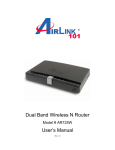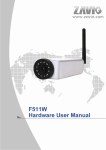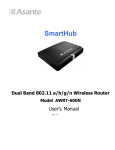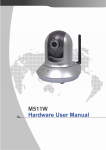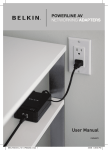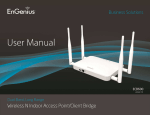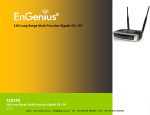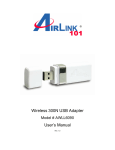Download Airlink101 AWLL7025 Network Card User Manual
Transcript
Dual Band Wireless N USB Adapter Model # AWLL7025 User’s Manual Rev. 1.0 Table of Contents 1. Introduction ................................................................................................................. 3 1.1 Package Contents ................................................................................................. 3 1.2 Features ................................................................................................................ 3 2. Install Utility and Driver................................................................................................ 4 3. Configure the Adapter ................................................................................................. 7 4. Use Wireless Monitor Utility ...................................................................................... 14 4.1 Link Information ................................................................................................... 14 4.2 AP List ................................................................................................................. 16 4.3 Configure Encryption Settings ............................................................................. 17 4.4 Profile Setting .......................................................................................................... 22 4.5 Configure IP Setting............................................................................................. 25 4.6 WiFi Protected Setup (WPS) ................................................................................... 26 4.6.1 PBC (Push Button Configuration) ..................................................................... 26 4.6.2 PIN (Personal Identifier Number)...................................................................... 27 4.7 About....................................................................................................................... 30 Appendix A – Specifications.......................................................................................... 31 Appendix B – Information .............................................................................................. 32 Technical Support ......................................................................................................... 36 2 1. Introduction Thank you for purchasing Airlink101 Dual Band Wireless N USB Adapter. The AWLL7025 Dual Band Wireless N USB Adapter can operate on either 2.4 or 5 GHz radio band depending on the current frequency of the Wireless Router or AP it connects to, which allows more clean channels and less interference for your wireless network. A full range of security features such as WPA2-PSK, WPA-PSK, and WEP provide the highest level of wireless network security. The Wireless Monitor Utility let you set up the USB Adapter with an easy-to-use user interface. You will be able to enjoy home entertainment with HD video streaming, VoIP and online gaming with the high wireless data rate of up to 300Mbps* when used with Airlink101® Dual Band Wireless N Router. 1.1 Package Contents Before you begin the installation, please check the items of your package. The package should include the following items: • • • • Dual Band Wireless N USB Adapter USB Extension Cable Quick Installation Guide Installation CD (Driver/Utility/Manual) 1.2 Features • Highest wireless data rate of up to 300Mbps with 802.11n draft 2.0 • Works with both 5 and 2.4GHz radio bands • Less interference, stronger signal and wider coverage • • Enhanced security, WiFi Protected Setup (WPA2, WPA) provide full protection for your wireless connection WPS button for easy connection to the existing wireless network • • • • • Great for environments with the need for higher wireless data traffic Supports Windows Vista / XP / 2000 Fully backward compatible with 802.11a/b/g RoHS compliant Works best with Airlink101 Dual Band Wireless N Router AR725W 3 2. Install Utility and Driver This Quick Installation Guide only provides the basic installation instructions. For detailed installation instructions on advanced features, please refer to the User’s Manual that can be found on the provided CD. Step 1 Insert the USB adapter into an available USB port of your computer. Step 2 Windows will launch the Found New Hardware Wizard. The Found New Hardware Wizard appears differently depending on your computer operating system, click Cancel to quit the wizard and insert the Installation CD in the CD drive. Continue to Step 3. Step 3 The Autorun screen will pop up. Click Install Utility and Driver from the menu. 4 Note: If the Autorun screen doesn’t appear automatically go to Start, Run, and type D:\Utility\Setup.exe (where D is the letter of your CD drive) and click OK. Windows Vista Users: At this point, you may get a warning message like the one below. Make sure that you click Allow to continue with the installation. Step 4 The InstallShield Wizard will popup. Click Next at the screen. 5 Step 5 Click Next to begin the installation. Step 6 Give Permission to Window to install the driver software For Windows Vista, click the Install this driver software anyway. For Windows XP click Continue Anyway at the Windows Logo Screen. For Windows 2000, click Yes at the Digital Signature Not Found prompt. Step 7 Select Yes, I want to restart my computer now and click Finish to complete the installation. Your computer will now be restarted. 6 3. Configure the Adapter This section describes how to connect your Dual Band Wireless N USB Adapter to a wireless network. Note to Windows XP Users: You must disable the Wireless Zero Configuration Utility in order to use the bundled Wireless Utility. Please follow the steps below to disable XP’s wireless utility. Step 1 Double-click on the Wireless Network Connection Icon in the system tray and then click on Properties or Advanced. Step 2 Go to the Wireless Networks tab, uncheck the “Use Windows to configure my wireless network settings” check box and click OK. If the Wireless Networks tab is not available, it means that Wireless Zero Configuration has been disabled. You can ignore this step. 7 Open the Airlink101 Wireless Monitor utility by double clicking on the Airlink101 Wireless Monitor Utility icon in the system tray at the bottom right-hand corner of your screen. Step 1 Click on AP List tab and select a Network Name (SSID) from the list you want to connect to and click Connect. 8 Step 2 If encryption is not enabled for the selected access point / router, skip to step 7. Otherwise, enter a Profile Name for your wireless setting and click Next. Step 3 Verify that the Network Name matches the wireless network you selected to connect and click Next. 9 Step 4 Verify that the Authentication Mode and Input Method match to your wireless router’s settings and click Next. Step 5 Input the encryption key for your wireless network and click Next. 10 Step 6 Keep the default IP Setting and click Complete. Step 7 You should see a blue circle around the antenna icon indicating a valid connection. 11 Step 8 Go to the Link Information tab and click on the More button. Step 9 Verify that you are receiving adequate Signal Strength and Link Quality and that you have been assigned a valid IP address (instead of all 0’s). 12 If you do not have adequate Signal Strength, try re-orienting the Access Point and/or the USB Adapter by using the USB Extension Cable included in the package to get a better reception. Troubleshooting If you are experiencing problems with the connection (unable to connect, low signal strength, slow connection speed, not working, unstable wireless connection) you may want to tune your router’s signal by changing the frequency (if your router supports 5 GHz) and channels on the router. You do not need to change the frequency or channel on the Adapter; it will automatically pick up the new settings after you reboot the router. For instructions on changing channels, refer to the documentation that comes with the router. 13 4. Use Wireless Monitor Utility This section describes the various functions of the Wireless Monitor Utility that you can configure, including the settings of wireless encryption. 4.1 Link Information The Link Information tab shows the current profile in use as well as details of the current network connection. Click on the More button to see the details of the current network connection. 14 The Wireless Information displays the current wireless network you are connected to as well as various other statuses such as the Signal Strength and your assigned IP address. 15 4.2 AP List The AP List tab displays all the available wireless networks detected by the USB Adapter. Simply select the desired wireless network you wish to connect to and click Connect. The Site Information displays a list of status for the selected AP, including the Channel number and the Encryption status. 16 4.3 Configure Encryption Settings This section describes how to configure encryption settings for the Dual Band Wireless N USB adapter. Note: The encryption settings you set for the Adapter must match the same settings of the Access Point / Wireless Router; otherwise, the adapter will not be able to connect wirelessly. Step 1 From the AP List tab, select the Access Point/Wireless Router you want to connect to and click Connect. 17 Step 2 Verify the Profile Name is correct and click Next. Step 3 Verify the Network Name (SSID) is correct and click Next. 18 For WEP Settings: WEP Step 4.1 Select the appropriate Authentication Mode and Encryption settings and click Next. WEP Step 4.2 Enter the appropriate Input Method, Key (password), Key Index, and click Next. 19 For WPA-PSK and WPA2-PSK Settings: WPA Step 4.1 Select WPA-PSK or WPA2-PSK and the appropriate Input Method and click Next. WPA Step 4.2 Enter the Key and click Next. 20 Step 5 Keep the default IP Setting and click Complete to finish the settings. Step 6 You should see a blue circle around the antenna icon indicating a valid connection. A lock icon beside the antenna indicates the connection is encrypted. 21 4.4 Profile Setting The Profile Setting tab lists all the profiles you have created. You can create new profiles for different network environments. To add a new profile, follow the steps below: Step 1 Click on the Add button. Step 2 Enter a name for your new profile and click Next. 22 Step 3 Enter the SSID (Network Name) of the wireless network you want to connect to and click Next. Step 4 Configure any encryption setting if required and click Next. 23 Step 5 Keep the default IP Setting and click Complete to finish the profile setting. Step 6 Your new profile will be listed in the Profile List. Step 7 You can quickly select which profile you want to use from the Link Information tab depending on your network environments without having to reconfigure the settings each time. 24 4.5 Configure IP Setting To change the IP settings of the wireless adapter, follow the steps below: Step 1 On the last step of 4.4 Profile Setting, under IP setting, select Enable and click Next. Step 2A Select Enable for DHCP Status if you want to get IP address automatically from DHCP server. Click Complete to finish the setting. Step 2B Select Disable for DHCP Status if you want to use static IP. Enter the IP Address, Subnet Mask, Default Gateway and DNS Server information. Click Complete to finish the setting. 25 4.6 WiFi Protected Setup (WPS) Airlink101 Dual Band Wireless N USB Adapter has an innovated built-in WPS (WiFiProtected Setup) feature which can synchronize and build a connection between any WPS support router safely and easily. You have two options for WPS wireless connection: PBC (Push Button Configuration) and PIN (Personal Identifier Number). If your wireless router does not support WPS feature, you can skip this section. In the instructions below, we are going to use the Airlink101 Dual Band Wireless N Router AR725W and Dual Band Wireless N USB Adapter AWLL7025 as the example. 4.6.1 PBC (Push Button Configuration) Step 1 Go to the computer with the USB adapter connected. Push and hold the WPS button on the bottom of the Adapter until you see the WPS window pops up on the computer monitor. WPS window: Step 2 Push the WPS button on the Router, and the blue LED will start blinking. 26 Step 3 The Router will now start the handshake with the wireless adapter. When you see the window below, the wireless connection has been established. 4.6.2 PIN (Personal Identifier Number) Step 1 To use the PIN method, go to Link Information tab, and click on WPS button. 27 Step 2 Click on Rescan button. The wireless router or AP you wish to connect to should appear in the list. Write down the PIN code on a piece of paper. Step 3 Go to a computer that is connected to the router (with a wire or wirelessly). Log in to the Router’s web configuration page from a web browser. Step 4 Click on Wireless Tab. Enter the PIN code and click Register. Within the following 2 minutes, go to the wireless client computer and do Step 5. 28 The router will start to search for the WPS enabled device with matching PIN code. Step 5 Select the Router/AP you want to connect to and click on PIN button. The progress of the WPS connection will be shown in the status bar to tell you that it is successful or failed. If it is failed, verify that you type in the correct PIN code in the Router’s configuration page and click the PIN button to try again. 29 4.7 About The About tab shows the Utility, Driver, and Firmware version as well as the MAC address of the Dual Band Wireless N USB Adapter. 30 Appendix A – Specifications Standards • IEEE 802.11n draft 2.0 • IEEE 802.11 a / b / g Frequency Band • 2.4 / 5Ghz System requirement • Windows Vista (32/64 bit), XP, 2000 • Available USB slot • Recommended use with Airlink101 Dual Band Wireless N Router AR725W Interface • USB 2.0 Weight • 21g Antenna type • 2 Integrated Antennas Dimensions • 94 x 11 x 10mm (L x W x H) Security • WPA-PSK(TKIP) • WPA2-PSK (AES) • WEP 64/128 bits • WPS Push Button/PIN Temperature • Operating: 0ºC to 40ºC • Storage: -10ºC to 75ºC LED • Link / Act QoS • WMM Humidity • Operating: 10% to 85% NonCondensing • Storage: 5% to 90% Non-Condensing Warranty • Limited 1-year warranty Safety Approvals • FCC, CE, IC 31 Appendix B – Information Federal Communication Commission Interference Statement This equipment has been tested and found to comply with the limits for a Class B digital device, pursuant to Part 15 of the FCC Rules. These limits are designed to provide reasonable protection against harmful interference in a residential installation. This equipment generates, uses and can radiate radio frequency energy and, if not installed and used in accordance with the instructions, may cause harmful interference to radio communications. However, there is no guarantee that interference will not occur in a particular installation. If this equipment does cause harmful interference to radio or television reception, which can be determined by turning the equipment off and on, the user is encouraged to try to correct the interference by one of the following measures: Reorient or relocate the receiving antenna. Increase the separation between the equipment and receiver. Connect the equipment into an outlet on a circuit different from that to which the receiver is connected. Consult the dealer or an experienced radio/TV technician for help. FCC Caution: Any changes or modifications not expressly approved by the party responsible for compliance could void the user's authority to operate this equipment. This device complies with Part 15 of the FCC Rules. Operation is subject to the following two conditions: (1) This device may not cause harmful interference, and (2) this device must accept any interference received, including interference that may cause undesired operation. IMPORTANT NOTE: FCC Radiation Exposure Statement: This equipment complies with FCC radiation exposure limits set forth for an uncontrolled environment. End users must follow the specific operating instructions for satisfying RF exposure compliance. To maintain compliance with FCC RF exposure compliance requirements, please follow operation instruction as documented in this manual. This transmitter must not be co-located or operating in conjunction with any other antenna or transmitter. SAR compliance has been established in typical laptop computer(s) with CardBus slot, and product could be used in typical laptop computer with CardBus slot. Other application like handheld PC or similar device has not been verified and may not compliance with related RF exposure rule and such use shall be prohibited. Operations in the 5.15-5.25GHz band are restricted to indoor usage only IEEE 802.11b or 802.11g operation of this product in the U.S.A. is firmware-limited to channels 1 through 11. 32 This device complies with RSS-210 of the Industry Canada Rules. Operation is subject to the following two conditions: 1) this device may not cause interference and 2) this device must accept any interference, including interference that may cause undesired operation of the device Caution: The device for the band 5150-5250 MHz is only for indoor usage to reduce potential for harmful interference to co-channel mobile satellite systems. IMPORTANT NOTE: IC Radiation Exposure Statement: This equipment complies with IC radiation exposure limits set forth for an uncontrolled environment. End users must follow the specific operating instructions for satisfying RF exposure compliance. To maintain compliance with IC RF exposure compliance requirements, please follow operation instruction as documented in this manual. This transmitter must not be co-located or operating in conjunction with any other antenna or transmitter. Europe – EU Declaration of Conformity This device complies with the essential requirements of the R&TTE Directive 1999/5/EC. The following test methods have been applied in order to prove presumption of conformity with the essential requirements of the R&TTE Directive 1999/5/EC: - EN60950-1: (2006) Safety of Information Technology Equipment - EN 62311 : (2007) - Generic standard to demonstrate the compliance of electronic and electrical apparatus with the basic restrictions related to human exposure to electromagnetic fields (0 Hz - 300 GHz) - EN 300 328 V1.7.1: (2006-10) - Electromagnetic compatibility and Radio spectrum Matters (ERM); Wideband Transmission systems; Data transmission equipment operating in the 2,4 GHz ISM band and using spread spectrum modulation techniques; Harmonized EN covering essential requirements under article 3.2 of the R&TTE Directive - EN 301 893 V1.4.1: (2007-07) - Broadband Radio Access Networks (BRAN);5 GHz high performance RLAN; Harmonized EN covering essential requirements of article 3.2 of the R&TTE Directive - EN 301 489-1 V1.6.1: (2005-09) 33 - Electromagnetic compatibility and Radio Spectrum Matters (ERM); ElectroMagnetic Compatibility (EMC) standard for radio equipment and services; Part 1: Common technical requirements EN 301 489-17 V1.2.1 (2002-08) Electromagnetic compatibility and Radio spectrum Matters (ERM); ElectroMagnetic Compatibility (EMC) standard for radio equipment and services; Part 17: Specific conditions for 2,4 GHz wideband transmission systems and 5 GHz high performance RLAN equipment This device is a 2.4 GHz wideband transmission system (transceiver), intended for use in all EU member states and EFTA countries, except in France and Italy where restrictive use applies. In Italy the end-user should apply for a license at the national spectrum authorities in order to obtain authorization to use the device for setting up outdoor radio links and/or for supplying public access to telecommunications and/or network services. This device may not be used for setting up outdoor radio links in France and in some areas the RF output power may be limited to 10 mW EIRP in the frequency range of 2454 – 2483.5 MHz. For detailed information the end-user should contact the national spectrum authority in France. 0560 Česky [Czech] Dansk [Danish] Deutsch [German] Eesti [Estonian] English Español [Spanish] Ελληνική [Greek] Français [Jméno výrobce] tímto prohlašuje, že tento [typ zařízení] je ve shodě se základními požadavky a dalšími příslušnými ustanoveními směrnice 1999/5/ES. Undertegnede [fabrikantens navn] erklærer herved, at følgende udstyr [udstyrets typebetegnelse] overholder de væsentlige krav og øvrige relevante krav i direktiv 1999/5/EF. Hiermit erklärt [Name des Herstellers], dass sich das Gerät [Gerätetyp] in Übereinstimmung mit den grundlegenden Anforderungen und den übrigen einschlägigen Bestimmungen der Richtlinie 1999/5/EG befindet. Käesolevaga kinnitab [tootja nimi = name of manufacturer] seadme [seadme tüüp = type of equipment] vastavust direktiivi 1999/5/EÜ põhinõuetele ja nimetatud direktiivist tulenevatele teistele asjakohastele sätetele. Hereby, [name of manufacturer], declares that this [type of equipment] is in compliance with the essential requirements and other relevant provisions of Directive 1999/5/EC. Por medio de la presente [nombre del fabricante] declara que el [clase de equipo] cumple con los requisitos esenciales y cualesquiera otras disposiciones aplicables o exigibles de la Directiva 1999/5/CE. ΜΕ ΤΗΝ ΠΑΡΟΥΣΑ [name of manufacturer] ∆ΗΛΩΝΕΙ ΟΤΙ [type of equipment] ΣΥΜΜΟΡΦΩΝΕΤΑΙ ΠΡΟΣ ΤΙΣ ΟΥΣΙΩ∆ΕΙΣ ΑΠΑΙΤΗΣΕΙΣ ΚΑΙ ΤΙΣ ΛΟΙΠΕΣ ΣΧΕΤΙΚΕΣ ∆ΙΑΤΑΞΕΙΣ ΤΗΣ Ο∆ΗΓΙΑΣ 1999/5/ΕΚ. Par la présente [nom du fabricant] déclare que l'appareil [type d'appareil] est conforme aux 34 [French] Italiano [Italian] Latviski [Latvian] Lietuvių [Lithuanian] Nederlands [Dutch] Malti [Maltese] Magyar [Hungarian] Polski [Polish] Português [Portugues e] Slovensko [Slovenian] Slovensky [Slovak] Suomi [Finnish] Svenska [Swedish] exigences essentielles et aux autres dispositions pertinentes de la directive 1999/5/CE. Con la presente [nome del costruttore] dichiara che questo [tipo di apparecchio] è conforme ai requisiti essenziali ed alle altre disposizioni pertinenti stabilite dalla direttiva 1999/5/CE. Ar šo [name of manufacturer / izgatavotāja nosaukums] deklarē, ka [type of equipment / iekārtas tips] atbilst Direktīvas 1999/5/EK būtiskajām prasībām un citiem ar to saistītajiem noteikumiem. Šiuo [manufacturer name] deklaruoja, kad šis [equipment type] atitinka esminius reikalavimus ir kitas 1999/5/EB Direktyvos nuostatas. Hierbij verklaart [naam van de fabrikant] dat het toestel [type van toestel] in overeenstemming is met de essentiële eisen en de andere relevante bepalingen van richtlijn 1999/5/EG. Hawnhekk, [isem tal-manifattur], jiddikjara li dan [il-mudel tal-prodott] jikkonforma malħtiġijiet essenzjali u ma provvedimenti oħrajn relevanti li hemm fid-Dirrettiva 1999/5/EC. Alulírott, [gyártó neve] nyilatkozom, hogy a [... típus] megfelel a vonatkozó alapvetõ követelményeknek és az 1999/5/EC irányelv egyéb elõírásainak. Niniejszym [nazwa producenta] oświadcza, że [nazwa wyrobu] jest zgodny z zasadniczymi wymogami oraz pozostałymi stosownymi postanowieniami Dyrektywy 1999/5/EC. [Nome do fabricante] declara que este [tipo de equipamento] está conforme com os requisitos essenciais e outras disposições da Directiva 1999/5/CE. [Ime proizvajalca] izjavlja, da je ta [tip opreme] v skladu z bistvenimi zahtevami in ostalimi relevantnimi določili direktive 1999/5/ES. [Meno výrobcu] týmto vyhlasuje, že [typ zariadenia] spĺňa základné požiadavky a všetky príslušné ustanovenia Smernice 1999/5/ES. [Valmistaja = manufacturer] vakuuttaa täten että [type of equipment = laitteen tyyppimerkintä] tyyppinen laite on direktiivin 1999/5/EY oleellisten vaatimusten ja sitä koskevien direktiivin muiden ehtojen mukainen. Härmed intygar [företag] att denna [utrustningstyp] står I överensstämmelse med de väsentliga egenskapskrav och övriga relevanta bestämmelser som framgår av direktiv 1999/5/EG. 35 Technical Support E-mail: [email protected] Toll Free: 1-888-746-3238 Web Site: www.airlink101.com *Theoretical maximum wireless signal rate derived from IEEE standard 802.11g and draft 802.11n specifications. Actual data throughput will vary. Network conditions and environmental factors, including volume of network traffic, building materials and construction, mix of wireless products used, radio frequency interference (e.g., cordless telephones and microwaves) as well as network overhead lower actual data throughput rate. This product is based on IEEE draft 802.11n specification and is not guaranteed to be compatible with future versions of IEEE 802.11n specification. Compatibility with draft 802.11n devices from other manufactures is not guaranteed. Specifications are subject to change without notice. Photo of product may not reflect actual content. All products and trademarks are the property of their respective owners. Copyright ©2009 Airlink101® 36




































